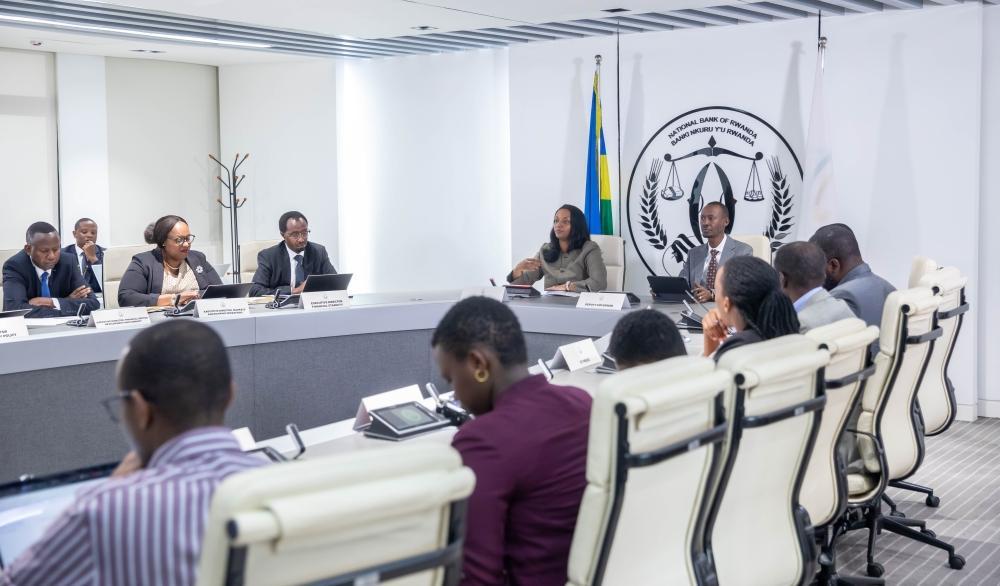Africa-Press – Rwanda. The Rwandan franc signaled firmness in the third quarter of 2025, with the National Bank of Rwanda reporting a depreciation of about 4 per cent to end-September.
The development marks one of the currency’s most stable periods in recent years, compared with 6.5 per cent over the same period in 2024 and the deeper 13.7 per cent recorded in 2023, according to the Central Bank Governor, Soraya Hakuziyaremye.
She told a press briefing that the improved trend reflects a combination of stronger export earnings, adequate foreign-exchange reserves, and ongoing reforms in the domestic FX market, conditions that helped ease pressure at a time when several economies across sub-Saharan Africa continue to face sharp currency swings.
A shop attendant counts Rwandan franc bills. The local currency showed relative stability in the third quarter of 2025, with the National Bank of Rwanda reporting a depreciation at about 4 percent by end-September. Photo: File
Governor Hakuziyaremye announced the development following the bank’s quarterly Financial Stability Committee and Monetary Policy Committee meetings, during which the team reviewed global, regional, and domestic economic developments for the third quarter of 2025.
According to the Bank, merchandise exports rose by 15 per cent in the quarter, driven by higher receipts from coffee, tea, and minerals, supported by stable global prices and domestic production.
She explained that non-traditional exports performed even more strongly, increasing by 50.5 per cent, largely on the back of processed cooking oil and wheat flour supplied to regional markets.
“Imports also grew, though at a slower pace of 7.4 per cent, which narrowed the gap between export and import growth. This contributed to a modest 2.8 per cent rise in the trade deficit for the period, a smaller increase compared with previous years,” the governor said.
Official statistics also indicated that foreign-exchange reserves stood at 4.2 months of import cover at the end of September.
The central bank said it considers this adequate to cushion short-term shocks and support confidence in the market, with strong tourism earnings, stable remittances, and firm service-sector performance adding to that buffer.
Part of the stability also stems from domestic foreign-exchange market reforms that the central bank has implemented to limit speculative tendencies.
Although the Governor did not outline the full list of measures, she said the reforms improved price formation and strengthened discipline within the market, helping ensure that movements in the franc reflect real demand and supply conditions.
External factors, including the US dollar weakening globally over the months leading up to September, eased pressure on many emerging and frontier currencies.
The bigger picture
According to the MPC, global commodity trends were favourable, with oil prices projected to decline by close to 16 per cent in 2025 and food prices expected to fall by 6.1 per cent.
These dynamics reduce imported inflation and moderate pressure on countries with high import bills, including Rwanda.
Inflation averaged 7.2 per cent in the third quarter, up from 6.7 per cent earlier in the year but still within the central bank’s target range of 2 to 8 per cent.
Hakuziyaremye said that the October reading stood at 7.1 per cent, but added that falling fresh-food prices, linked to improved harvests, helped offset higher core and energy inflation.
The Bank, she maintained, projects average inflation of 6.9 per cent for 2025, dropping to 5.8 per cent in 2026.
Regionally, currency performance remains mixed. Some countries in the south and the Horn of Africa are still experiencing severe depreciation and high inflation, in some cases above 50 per cent.
For households, a steadier franc reduces the risk of sudden price surges on imported goods such as fuel, medical supplies, and everyday consumer products.
While prices remain high in some categories, the absence of sharp monthly movements prevents further strain on living costs.
Businesses also benefit from reduced volatility.
For instance, importers face fewer unexpected cost jumps, while exporters retain competitiveness without dealing with abrupt swings that complicate pricing, contracts, or hedging decisions.
Hakuziyaremye said that the Central Bank remains cautious despite the improved stability, given that weather-related shocks, shifts in global trade, geopolitical tensions, and commodity-price volatility present risks that could quickly influence foreign exchange flows.
Gold investments are paying off
Reacting to the Central Bank’s decision to add gold holdings to the Bank’s reserve mix, Governor Hakuziyaremye told The New Times that returns have been more than “we expected.”
“It is true that the Central Bank had indicated we were assessing gold as a potential reserve asset based on its record in capital preservation, stable returns, and liquidity. We have since begun investing in gold,” she revealed.
“While we do not disclose our portfolio composition, our strategic asset allocation provides room to hold gold in proportions consistent with other central banks, and for emerging economies, that can go up to about 10 per cent of total reserves,” she added.
On price movements, she said, “As a central bank, we are long-term investors, not traders, but since January, gold has gained roughly 57 per cent in value, despite its volatility.”
“In recent months, prices have edged down, though they remain above where they were at the start of the year. We are managing that risk, and overall, the return has exceeded our expectations,” she added.
Historically, gold prices have grown by an average of around 11 per cent annually over the past two decades.
“We recognise that prices can decline depending on global factors, but at this stage we are comfortable with our position, and this remains an asset we intend to keep within our investment portfolio,” the governor noted.
For More News And Analysis About Rwanda Follow Africa-Press






